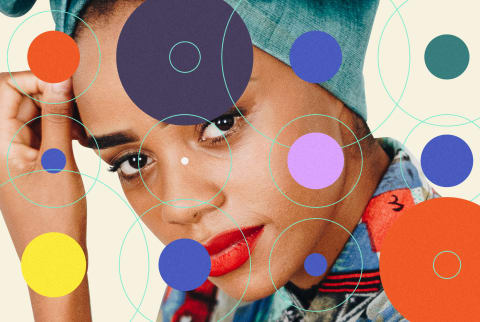Advertisement
Your Guide To The 7 Chakra Colors & How To Use Them


Chakras are the body's energy centers. The main seven chakras run up the spinal cord—beginning at the base of the spine and ending at the crown of the head. They each correspond to different needs and emotions (starting with basic survival and ending with a connection to spirit and the universe), and they each have their own color, too. The colors of the chakras follow the ROYGBIV color sequence, beginning with red and ending with violet.
Unblocking and balancing your chakras can be a powerful way to release or heal stagnant energy, and understanding these colors can aid in your chakra work.
Why are the chakra colors important, and how should I work with them?
"Each chakra color carries a particular vibrational frequency that you can tap into, work with, and amplify," explains acupuncturist, reiki master, and author of Chakra Healing Margarita Alcantara, LAc. "Delving into healing at this level is very powerful."
Keeping this in mind, working with a particular chakra color can help you draw that color's energy—or frequency—into your life. When deciding on a color to incorporate into your practice, consider what energy you are looking for right now. Then, scan the list below to find the color that corresponds to it.
Alcantara recommends working with your chosen chakra color(s) using visualization: Picture that color as a sphere of light that exists in your body and watch it grow and radiate. Visualize it becoming stronger and more vibrant with each breath.
If you're into crystals, you can also seek out a stone that corresponds to your chosen color and work it into your spiritual practice. Hold it during meditation, add it to your altar, or carry it around as a reminder of an intention.
Root Chakra
Color: Red
The root chakra is our foundation. It develops in our first seven years of life and deals with survival and security needs. It's represented by the color red, and when out of balance, we may feel insecure, unsafe, and even disconnected from reality.
Stone: Hematite
Hematite, a reddish-black mineral, is a good stone to work with to nourish your roots.
Sacral Chakra
Color: Orange
The sacral chakra, which is located in your lower abdomen, is all about creativity and sexuality. It's associated with orange and is formed in the seven years after your root chakra until age 14. (This seven-year timeline continues with each chakra as we get older).
Stone: Tiger's Eye
The orange quality of tiger's eye makes it a good stone to work with if your sacral chakra is out of balance and you feel a lack of control in your life.
Solar Plexus Chakra
Color: Yellow
Moving from the lower to the upper abdomen, you'll find your solar plexus chakra, which is associated with the color yellow. This chakra deals with confidence as well as overall self-worth and self-esteem.
Stone: Amber
If you've been feeling any sort of shame or self-doubt, you may likely feel it in your gut. In this case, one yellow stone you can work with is amber.
Heart Chakra
Color: Green
Up next is the heart chakra—located just above your heart in the center of your chest—which is associated with the color green. It deals with our ability to both give and receive love to ourselves and others.
Stone: Rose Quartz
This is the one exception to crystal-color coordination: "Pink rose quartz is the premier stone when working with the Heart Chakra," Alcantara notes.
Throat Chakra
Color: Light Blue/Turquoise
The throat chakra, which is associated with light blue or turquoise, is all about expression and truth. When it's open, we can communicate our truth clearly and effectively. When it's blocked, we struggle to share authentically.
Stone: Blue Lace Agate
The beautiful light blue shade of this stone makes it excellent for throat chakra work.
Third-Eye Chakra
Color: Dark Blue/Purple
As we get older, we get closer and closer to self-actualization. From ages 36 to 42, our third-eye chakra develops, and it's associated with dark blue and purple shades. It deals with intuition and our ability to move past our ego. When it's unbalanced, we'll feel out of touch with our intuition.
Stone: Amethyst or Lapis Lazuli
Amethyst, with its rich purple tones, or dark blue lapis lazuli are both good stones for this chakra.
Crown Chakra
Color: Violet/White
And lastly, at the crown of our head, we have the crown chakra. The final chakra is associated with shades of violet and glowing white. It develops when someone has become evolved enough to tap into higher consciousness—something that can take a lifetime and doesn't happen for everyone.
Stone: Clear Quartz
Clear quartz is a good stone for working with this chakra since it's thought to help open you up to spiritual connection.
The more we understand about the chakras, the better we can work with them to live balanced and aligned lives. If you think any of your chakras could be blocked, working with their colors is a great way to start getting back into balance. And if you want to move past colors and dig deeper into the subtle energies of each chakra, here are some more chakra-balancing tips.